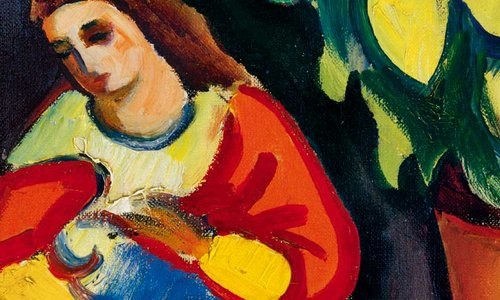Westphalian Expressionism
31 Oct 2010 - 20 Feb 2011

August Macke
Stillleben mit Madonna / Still Life with Madonna, 1911
Oil on canvas on cardboard
67 x 51.5 cm, Kunsthalle Bielefeld
Photo: Uslar Fotodesign, Bielefeld
Stillleben mit Madonna / Still Life with Madonna, 1911
Oil on canvas on cardboard
67 x 51.5 cm, Kunsthalle Bielefeld
Photo: Uslar Fotodesign, Bielefeld
WESTPHALIAN EXPRESSIONISM
31 October 2010 – 20 February 2011
In 1902, when Karl Ernst Osthaus founded the Folkwang Museum in Hagen, opening up his collection to the public, modernism moved into Westphalia. With it arose Westphalian Expressionism, which, by the 1930s, had established a style all its own, blending rural traditions and modern city life, and made an important contribution to German modernism.
Yet, between the Brücke (Bridge) and the Blauer Reiter (Blue Rider), between the German art centers of Dresden, Berlin, and Munich—where Expressionists were talked about and the art world and the spirit of the times were in revolution—the region from the Ruhr District to the Teutoburger Forest rarely got the attention it deserved, and Westphalia’s modernists only occasionally caught the eye of the art world. It was not until 1933, when the National Socialists banned the progressive-minded Vereinigung westfälischer Künstler und Kunstfreunde (Association of Westphalian artists and friends), that their achievements over time became obvious.
With this large exhibition of approximately 180 paintings, watercolors, drawings, and prints by artists such as Peter August Böckstiegel, Else Lohmann, August Macke, Carlo Mense, and Hermann Stenner, the Kunsthalle Bielefeld is presenting a fundamental survey of Westphalian Expressionism.
Catalogue: Hirmer, 240 pp., 24.95 € (museum price).
The exhibition is sponsored by the Sparkasse Bielefeld. Further financial support has been provided by the P. A. Böckstiegel-Förderkreis.
31 October 2010 – 20 February 2011
In 1902, when Karl Ernst Osthaus founded the Folkwang Museum in Hagen, opening up his collection to the public, modernism moved into Westphalia. With it arose Westphalian Expressionism, which, by the 1930s, had established a style all its own, blending rural traditions and modern city life, and made an important contribution to German modernism.
Yet, between the Brücke (Bridge) and the Blauer Reiter (Blue Rider), between the German art centers of Dresden, Berlin, and Munich—where Expressionists were talked about and the art world and the spirit of the times were in revolution—the region from the Ruhr District to the Teutoburger Forest rarely got the attention it deserved, and Westphalia’s modernists only occasionally caught the eye of the art world. It was not until 1933, when the National Socialists banned the progressive-minded Vereinigung westfälischer Künstler und Kunstfreunde (Association of Westphalian artists and friends), that their achievements over time became obvious.
With this large exhibition of approximately 180 paintings, watercolors, drawings, and prints by artists such as Peter August Böckstiegel, Else Lohmann, August Macke, Carlo Mense, and Hermann Stenner, the Kunsthalle Bielefeld is presenting a fundamental survey of Westphalian Expressionism.
Catalogue: Hirmer, 240 pp., 24.95 € (museum price).
The exhibition is sponsored by the Sparkasse Bielefeld. Further financial support has been provided by the P. A. Böckstiegel-Förderkreis.
